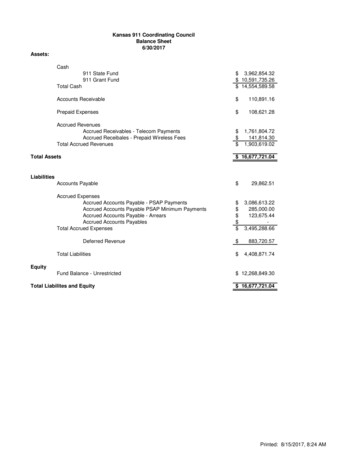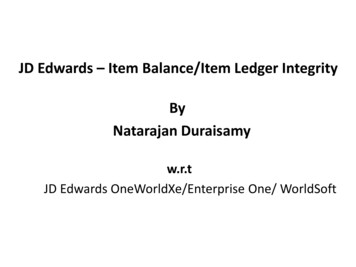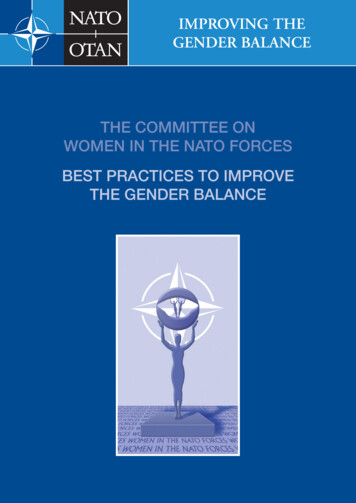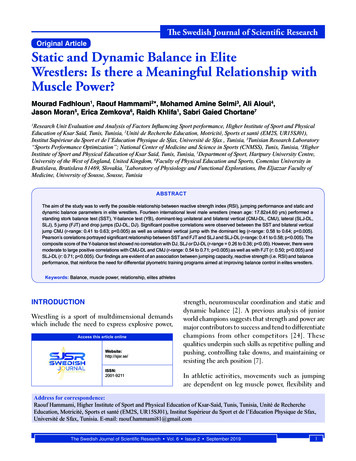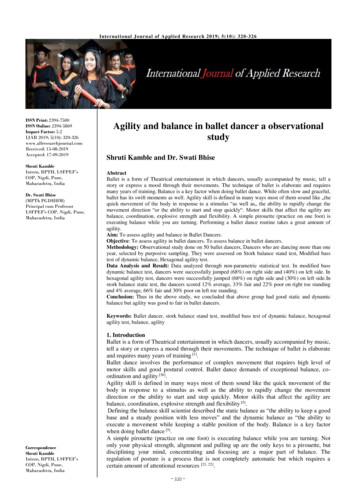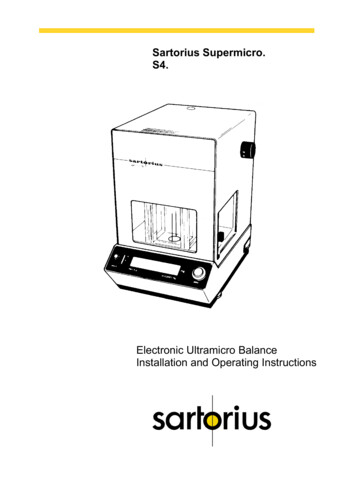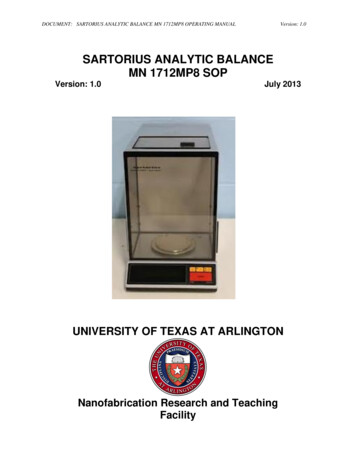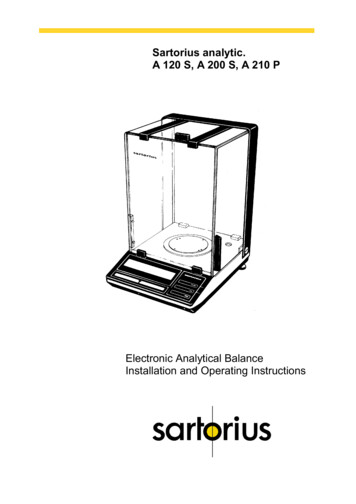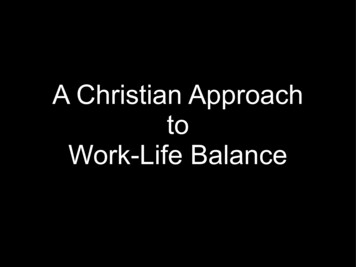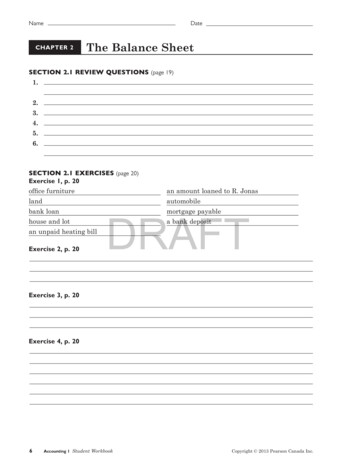
Transcription
NameDateCHAPTER 2The Balance SheetSECTION 2.1 REVIEW QUESTIONS (page 19)1.2.3.4.5.6.SECTION 2.1 EXERCISES (page 20)Exercise 1, p. 20office furniturean amount loaned to R. Jonaslandautomobilebank loanhouse and lotan unpaid heating billExercise 2, p. 20DRAFTmortgage payablea bank depositExercise 3, p. 20Exercise 4, p. 206Accounting 1 Student WorkbookCopyright 2013 Pearson Canada Inc.
NameDateSECTION 2.1 EXERCISES (continued)Exercise 5, p. 20AssetsLiabilitiesEquityExercise 6, p. 20A. AssetsDRAFTB. LiabilitiesC. EquityCopyright 2013 Pearson Canada Inc.Chapter 2 The Balance Sheet7
NameDateSECTION 2.2 REVIEW QUESTIONS (page 8Accounting 1 Student WorkbookCopyright 2013 Pearson Canada Inc.
NameDateSECTION 2.2 EXERCISES (page 28)Exercise 1, p. 28A.B.Exercise 2, p. 29DRAFTCopyright 2013 Pearson Canada Inc.Chapter 2 The Balance Sheet9
NameDateSECTION 2.2 EXERCISES (continued)Exercise 3, p. 30DRAFTSECTION 2.3 REVIEW QUESTIONS (page 32)1.2.3.4.5.SECTION 2.3 EXERCISES (page 32)Exercise 1, p. 32A.B.10Accounting 1 Student WorkbookCopyright 2013 Pearson Canada Inc.
NameDateSECTION 2.3 EXERCISES (continued)Exercise 2, p. 32A.B.DRAFTSECTION 2.4 REVIEW QUESTIONS (page 37)1.2.3.4.5.6.7.8.9.10.Copyright 2013 Pearson Canada Inc.Chapter 2 The Balance Sheet11
NameDateSECTION 2.4 REVIEW QUESTIONS (continued)11.12.13.14.15.16.17.DRAFTSECTION 2.4 EXERCISES (page 38)Exercise 1, p. 38A.12Accounting 1 Student WorkbookCopyright 2013 Pearson Canada Inc.
NameDateSECTION 2.4 EXERCISES (continued)Exercise 1, p. 38 (continued)B.C.DRAFTD.Copyright 2013 Pearson Canada Inc.Chapter 2 The Balance Sheet13
NameDateSECTION 2.4 EXERCISES (continued)Exercise 2, p. 38A. to C.AssetsAmountAccounts Receivable16 520Business Bank Balance1 852Business Automobiles48 054Furniture and Appliances6 528Government Bonds of Owner20 000House and Lot599 600Office Furniture and Equipment18 324Office Supplies3 545Owner’s Automobiles18 657Paving Materials55 326Plant Property and BuildingsSummer CottageTrucks and EquipmentTotal AssetsPersonal 27 460Boat and MotorPersonal Bank BalanceBusinessDRAFT10 258725 358265 874285 657LiabilitiesAccounts Payable 3 500Business Bank Loan156 000Mortgage on Plant Property375 000Mortgage on House and Lot260 000Mortgage on Summer CottageOwed to Finance Co.—Business Equipment92 300136 522Total LiabilitiesOwner’s Equity/Personal Net Worth14Accounting 1 Student WorkbookCopyright 2013 Pearson Canada Inc.
NameDateSECTION 2.4 COMMUNICATE IT (page 39)SECTION 2.5 REVIEW QUESTIONS (page 43)1.2.3.4.5.6.DRAFT7.8.9.10.Copyright 2013 Pearson Canada Inc.Chapter 2 The Balance Sheet15
NameDateSECTION 2.5 EXERCISES (page 44)Exercise 1, p. 44This is a spreadsheet exercise. Attach a copy of your spreadsheet to your Workbook.A. to D.DRAFTE.Exercise 2, p. 44This is a spreadsheet exercise. Attach a copy of your spreadsheet to your Workbook.SECTION 2.5 PERSONALIZE IT (page 45)This is a spreadsheet exercise. Attach a copy of your spreadsheet to your Workbook.16Accounting 1 Student WorkbookCopyright 2013 Pearson Canada Inc.
NameDateSECTION 2.5 COMMUNICATE IT (page 46)This is a spreadsheet exercise. Attach a copy of your spreadsheet to your Workbook.A., B.C.CHAPTER 2DRAFTREVIEW EXERCISES(page 47)Using Your KnowledgeExercise 1, p. 47Circle the best answer to each question.A. The financial position of a business isa. the difference between total assets and total liabilities.b. represented by the assets, the liabilities, and the capital.c. the same as the net worth of the business.Copyright 2013 Pearson Canada Inc.Chapter 2 The Balance Sheet17
NameDateCHAPTER 2 REVIEW EXERCISES (continued)Exercise 1, p. 47 (continued)B. If the total assets increase by 10 000 and the total liabilities decrease by 10 000,the capital willa. increase by 20 000.b. be unchanged.c. decrease by 20 000.C. Which one of the following is not true?a. A – E Lb. A – L Ec. A L Ed. A L ED. A balance sheet showsa. all of the owner’s assets and liabilities.b. a financial picture of the business on a certain date.c. the progress of the business over a period of time.E. Which one of the following is not true?a. The heading of a balance sheet shows the date as of which it was prepared.b. Assets are listed in the order of their liquidity (under ASPE).c. Accounts receivable are considered to be a liquid asset.d. Personal assets have no place on the business balance sheet.e. A truck that cost 10 000 and for which 6000 is owed is listed on the balancesheet at 4000.DRAFTF. Abbreviations may be used on financial statementsa. when it is necessary to crowd things to conserve space.b. to save time in preparing the statements.c. in a company name if the abbreviation is a formal part of the name.G. Which one of the following is not true? Ruled lines area. used to underline headings.b. used to indicate that columns of numbers are to be totalled.c. necessary to separate sections of the balance sheet.d. doubled to indicate a final total.H. Before a business is closed down, the equation for it isAssets ( 125 000) Liabilities ( 37 000) Equity ( 88 000)If assets of 70 000 are sold for 20 000, assets of 50 000 are sold for 90 000, and theremaining assets stay the same, the equation will becomea. 55 000 37 000 18 000b. 115 000 37 000 78 000c. 75 000 37 000 38 000d. 135 000 47 000 88 000e. 115 000 27 000 88 00018Accounting 1 Student WorkbookCopyright 2013 Pearson Canada Inc.
NameDateCHAPTER 2 REVIEW EXERCISES (continued)Exercise 1, p. 47 (continued)I. Which of the following is not true?a. In the liability section on a balance sheet, accounts payable may be listed first.b. On a balance sheet, there are three main totals.c. On a balance sheet, the owner’s name appears only in the heading.d. On a balance sheet, the final totals are always on the same line.J. Which of the following is true?a. IFRS must be used by all businesses in Canada.b. In many countries using IFRS, the liquidity order of assets is inverted.c. Canadian GAAP has replaced ASPE.d. The IASB controls the AcSB.Exercise 2, p. 48Exercise 3, p. 48Exercise 4, p. 48Exercise 5, p. 49A.DRAFTCopyright 2013 Pearson Canada Inc.Chapter 2 The Balance Sheet19
NameDateCHAPTER 2 REVIEW EXERCISES (continued)Exercise 5, p. 49 (continued)B.Exercise 6, p. 49A.DRAFTB.20Accounting 1 Student WorkbookCopyright 2013 Pearson Canada Inc.
NameDateCHAPTER 2 REVIEW EXERCISES (continued)Exercise 7, p. 49A.B.Exercise 8, p. 50Questions for Further Thought, p. 501.2.3.DRAFT4.5.6.7.Copyright 2013 Pearson Canada Inc.Chapter 2 The Balance Sheet21
NameDateCASE STUDIES (page 51)Case 1 Is Money Better? (p. 51)Case 2 Can you Spend the Equity? (p. 52)DRAFTCase 3: Challenge Are the Assets Always Worth What the Balance Sheet Says? (p. 52)1.2.3.4.22Accounting 1 Student WorkbookCopyright 2013 Pearson Canada Inc.
NameDateCASE STUDIES (continued)Case 3: Challenge Are the Assets Always Worth What the Balance Sheet Says? (continued)5.DRAFTCase 4: Co-operative Learning Should Your Friends Purchase This Business? (p. 54)Copyright 2013 Pearson Canada Inc.Chapter 2 The Balance Sheet23
NameDateCAREERMichael Tam/University Student(page 55)Discussion (p. 56)1.2.3.Research and Writing Questions (p. 56)4.DRAFT5. Attach a copy of your report to your Workbook.24Accounting 1 Student WorkbookCopyright 2013 Pearson Canada Inc.
Government Bonds of Owner 20 000 House and Lot 599 600 Offi ce Furniture and Equipment 18 324 Offi ce Supplies 3 545 Owner’s Automobiles 18 657 Paving Materials 55 326 Personal Bank Balance 10 258 Plant Property and Buildings 725 358 Summer Cottage 265 874 Trucks and Equipment 285 657 Total Assets Liabilities Accounts Payable 3 500 Business Bank Loan 156 000 Mortgage on Plant Property
